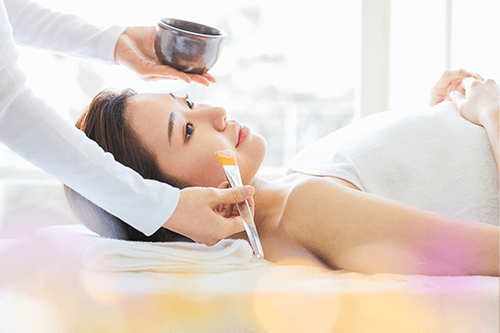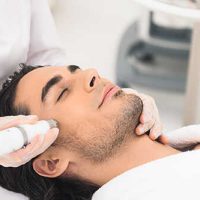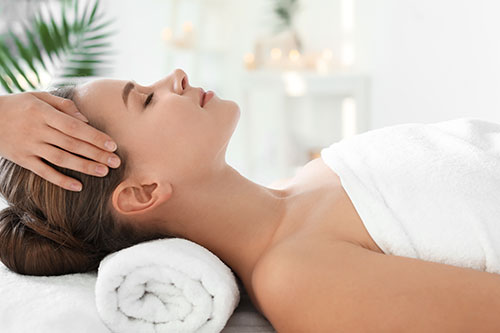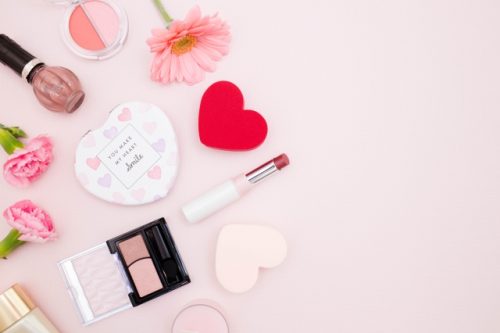Chemical peeling is a skin treatment that artificially promotes cell turnover by applying a preparation to the skin. Chemical peeling is effective for keratin plugs, acne , age spots , fine wrinkles, etc., and the effectiveness varies depending on the concentration and type of preparation, from those that act on the stratum corneum on the surface of the skin to those that act on the dermis layer deep in the skin.
Table of Contents
- 01. Chemical peeling is a medical procedure that promotes skin regeneration.
- 02. Chemical peeling originated with the beauty queen of ancient Egypt
- 03.Types of Chemical Peels at Hiro Clinic Cosmetic Dermatology
- 03-1. Glycolic acid peeling
- 03-2. Lactic acid peeling
- 03-3. Massage peeling
- 04. Precautions for Chemical Peeling
- 05. Choosing the right chemical peel for your skin condition
Chemical peeling is a medical procedure that promotes skin regeneration.
Human skin is divided into the stratum corneum, epidermis, and dermis layers from the surface of the skin. Our skin is constantly undergoing a process of turnover, in which new cells are produced and old keratin (so-called dirt) is expelled. However, environmental damage can disrupt the turnover cycle, or old keratin cannot be expelled normally, causing a decrease in the skin’s moisture content, leading to various skin problems such as rough skin and reduced elasticity.
Chemical peeling is a skin treatment that applies a preparation to the skin and artificially peels off old dead skin cells to regulate the disruption of cell turnover. The effects of chemical peeling include improving dark pores, acne , age spots , and fine wrinkles, and the preparations used are mainly glycolic acid , salicylic acid, alpha hydroxy acid, trichloroacetic acid, or a combination of these.

Chemical peeling originated from the beauty queen of ancient Egypt
It is said that chemical peeling originated with the famous ancient Egyptian beauty Cleopatra. Cleopatra, who could be called the original beauty girl, generously used beauty ingredients extracted from rare plants and animals to maintain beautiful skin.
Among them is a document describing a beauty treatment called bathing in donkey milk. The ingredients in donkey milk were said to soften the skin and restore its luster, and this could be considered the beginning of what we now call chemical peeling .
Types of Chemical Peels at Hiro Clinic Cosmetic Dermatology
The effects of chemical peels vary slightly depending on the type and concentration of the preparation used. The main effects include the improvement of darkened pores, enlarged pores, dullness, acne , acne scars, fine lines, oily skin, dry skin, and sun spots .
The types of chemical peels offered at Hiro Clinic Cosmetic Dermatology are ” glycolic acid peel ,” ” lactic acid peel ,” and ” massage peel .”
●Glycolic acid peeling
Glycolic acid peeling is said to suit the skin type of Japanese people and is the most commonly used formulation for chemical peeling. It penetrates the skin well and is often used to treat rough skin and acne caused by keratin plugs .
When using glycolic acid peeling , the concentration of the formulation is adjusted depending on the condition of the skin. Hiro Clinic Cosmetic Dermatology uses glycolic acid peeling with a formulation of the appropriate acidity that puts less strain on the skin. Even those who have given up on previous glycolic acid peeling treatments due to the strong irritation can now have the treatment with peace of mind.
Glycolic acid peeling is a treatment that promotes skin turnover by artificially peeling off the keratin on the surface of the skin with a preparation. Therefore, the treatment cycle is approximately once every three weeks, and repeated treatments will lead to beautiful, healthy skin. Although it depends on the condition of your skin, it takes an average of about five treatments for glycolic acid peeling to be effective.
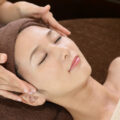
●Lactic acid peeling
” Lactic acid ” exists in the tissues of many animals and plants. It is also a component that is found in large amounts in fermented milk products such as lactic acid drinks. Lactic acid peeling is a preparation that uses natural lactic acid , and is also called lacto peeling . It is a peeling treatment that is relatively gentle because the molecules are larger than glycolic acid peeling preparations and act on the surface of the skin .
Lactic acid peeling preparations have whitening and astringent properties, so they are said to be effective against dull skin, blemishes , uneven skin tone, etc. In addition, they increase the production of ceramide, an intercellular lipid that determines the skin’s moisturizing ability, making them a suitable peeling treatment for those who suffer from dry skin.
Lactic acid peeling is less irritating than glycolic acid peeling , and has a milder effect on the skin, so it is possible to perform the treatment in a short period of time. At Hiro Clinic Cosmetic Dermatology, we recommend glycolic acid peeling once every three weeks, and basic lactic acid peeling once every three weeks, but if your acne is severe, we perform treatments as quickly as two weeks. If you are looking to improve your acne and achieve whiter skin, please feel free to contact us.

●Massage peeling
Massage Peel (PRX-T33) is a new peeling agent developed by the Italian company WiQo med , and its action and effects are different from previous chemical peels . A typical chemical peel is a treatment that uses an acidic preparation to artificially peel off keratin that is not normally excreted. Therefore, depending on the preparation used and its concentration, there are many cases where redness or irritation (pain) is felt. In addition, chemical peels aimed at treating crater-like acne scars have a strong effect on the dermis layer deep in the stratum corneum, but they require downtime.
Massage peel is a peeling agent that does not remove keratin, but acts directly on the dermis layer to promote the activation of fibroblasts . Therefore, it is mild to the skin, and there is very little downtime such as redness, heat, or peeling after the treatment. Massage peel is a skin quality improvement treatment that is also called collagen peel because it produces skin elasticity substances such as skin collagen.

Chemical peel precautions
Chemical peeling is a relatively inexpensive cosmetic treatment that improves skin quality with little pain or downtime. However, because chemical peeling is a treatment that utilizes cell turnover, dramatic results will not be seen with just one treatment. The appropriate treatment period and number of treatments will vary depending on the symptoms, such as acne and blemishes , after a doctor’s examination.
In addition, the skin is delicate immediately after chemical peeling . Avoid excessive irritation such as friction, protect from UV rays, and moisturize thoroughly. Depending on the type of chemical peel , redness and peeling may occur, but this usually subsides within a few days. In the unlikely event that you experience any abnormalities such as persistent skin heat or pain, please immediately consult the medical institution that performed the chemical peeling treatment.
Choosing the right chemical peel for your skin condition
Acne and blemishes are types of skin diseases. Treating and improving them is considered a medical procedure. Therefore, chemical peeling at beauty salons only has the same effects as cosmetics, such as “removing dirt from pores” and “moisturizing the skin,” and the Pharmaceuticals and Medical Devices Act stipulates that low-concentration preparations must be used.
In addition, there are various symptoms of acne and blemishes , and choosing the wrong preparation or treatment method may worsen the condition. For these reasons , a proper examination by a doctor is necessary to perform a safe chemical peel . At Hiro Clinic Cosmetic Dermatology , we carefully examine the condition of the patient’s skin and suggest the appropriate treatment for the symptoms. Please feel free to consult us about any skin concerns you may have, such as blackheads, acne , blemishes, and fine wrinkles, and the treatments we can apply.
Risks and side effects of chemical peels
- Redness
- Irritation
- Peeling, etc.
[References]
- Japanese Dermatological Association – Chemical Peeling

 JA
JA
 中文
中文
 EN
EN

